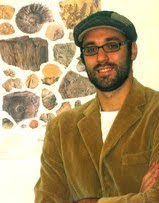<< It is self-evident that nothing concerning art is self-evident. >>
— Theodor Adorno
Geology is expressed in art through a plethora of media, styles and movements. For instance, it seems very difficult to find an order or a “common line” between Leonardo da Vinci and Per Kirkeby.
Accordingly, I defined Geologic Art as “a collective term for artistic phenomena in which geology brings its own aesthetic and conceptual baggage” (Baucon, 2010). Indeed Geologic Art cannot be regarded a style or a movement; nevertheless, it is a definite, peculiar field as it records the work of ‘geologic thinkers’ (sensu Andrews, 2003).
 |
| Thomas Cole, Oxbow or the Connecticut River near Northampton, 1836. |
Some places are special for ‘geologic thinkers’. For instance, the 19th century saw artists and scientists celebrating the geology of the Hudson River. According to Rebecca Bedell (2001): “Thomas Cole, Asher Durand, Frederic Church, John F. Kensett, William Stanley Haseltine, Thomas Moran, and other artists read scientific texts, participated in geologic surveys, and carried rock hammers into the field to collect fossils and mineral specimens. As they crafted their paintings, these artists drew on their geologic knowledge to shape new vocabularies of landscape elements resonant with moral, spiritual, and intellectual ideas”.
This phenomenon – known as the Hudson School – involved geology in its scientific and artistic expression.
 |
| Thomas Cole's Rock Collection (from Explore Thomas Cole, a comprehensive website about the founder of the Hudson School). |
Special places continue to inspire geological thinkers still nowadays. In fact, geology and art meet at Coldigioco (Italy), a hilltop village sitting among mystical peaks and lyrical woodlands. In this unique scenario Alessandro Montanari (geologist and “geo-musician”) and his wife Paula Metallo (artist and educator) restored and rebuilt an old town, creating the Osservatorio Geologico di Coldigioco (Geological Observatory of Coldigioco), which is described as “an independent center for research and education in geology, art, and cuisine”.
Alessandro and Paula are Coldigioco's permanent residents, but the geological observatory is a vivid meeting point for geological thinkers from all over the world. Indeed Coldigioco provides extensive facilities for geoscientists and it is intensively involved in artistic initiatives.
 |
| Monte San Vicino and the surroundings of Coldigioco. Coldigioco is located near the center of the image along one of the ridges ascending toward the mountain. From the Geological Observatory of Coldigioco Website. |
Since 1992, the Geologic Observatory of Coldigioco has hosted numerous science, art and culinary programs and conferences. Geoscientists use it as a base from which to study the amazing geology of the Apennines. Its vibrant cultural and natural environment is a vivid source of inspiration for artists.
It appears manifest that the Geological Observatory of Coldigioco could be considered a sort of 'GeoArt's navel'. For exploring this unique cultural scenario, it is necessary a 'first-hand' opinion. For this reason I interviewed some of the artists revolving around Coldogioco, starting from its founders: Alessandro Montanari and Paula Metallo.
1. What led you to found the Geological Observatory of Coldigioco?
A love for spontaneity and a sort of naive trust in coincidence.
2. Could you define Coldigioco Geologic Observatory?
What is Coldigioco? Here are a few of the things we love about Coldigioco .... the rural landscape that is so beautiful, the peace, the sense of community, the many stimulating conversations, the give and take in learning about each others disciplines - and how we always feel a creative jump start. But most importantly for us we love sharing with students, the Coldigioco life and all of our accomplishments, and that special-Coldigioco-something that each person who visits feels changed for the better and connected to everyone else who loves Coldigioco. That in and of itself if we have accomplished nothing else (which we have) is an extraordinary feat!
3. What are the greatest challenges facing the Geological Observatory of Coldigioco?
Financial. It is often small or emerging organizations that generate provocative ideas, reframe an issue, or look at persistent problems in new ways. I think we are particularly effective at challenging old ways of approaching problems. Especially university level education and research. Even though it should be said that we have yet to find a formula to penetrate and participate in the Italian university system in a way that could begin to transform its inertia.
The initial energy and excitement we and our group of friends had was enough for the initial push but long-term growth has been difficult to keep up with as we get older. As organizers, caretakers, educators and researchers, Sandro and I are just now able to deligate those jobs that took time and energy away from research that permitted us to offer quality work.
The above lines suggest the existence of a 'Coldigioco School' of GeoArt. Is it really true? Who are the artists revolving around Coldigioco? And who are the geoscientists? What is the relationship between Coldigioco, music and geology? How Coldigioco inspire visual arts and what is the role of geology in this process?
The answers - and much more - are coming soon: this December, on the Geology in Art Webzine!
REFERENCES
Andrews S. 2003. Spatial thinking with a difference: an unorthodox treatise in the mind of the Geologist. AEG News, 45(4) and 46(1-3)
Baucon A., 2009. Geology in Art. An Unorthodox Path from Visual Arts to Music. geologyinart.com / tracemaker.com, 120 pages
Bedell, R. 2001. The Anatomy of Nature: Geology and American Landscape Painting 1825-1875. Princeton, Princeton Press, 185 pp.







No comments:
Post a Comment